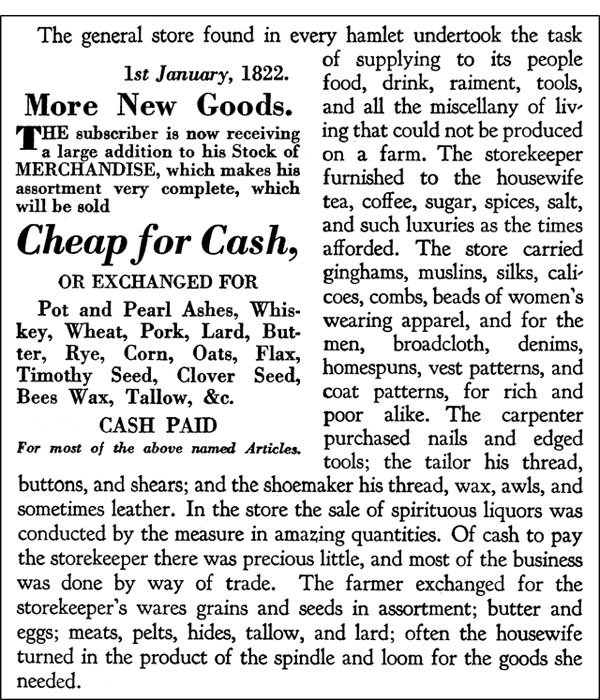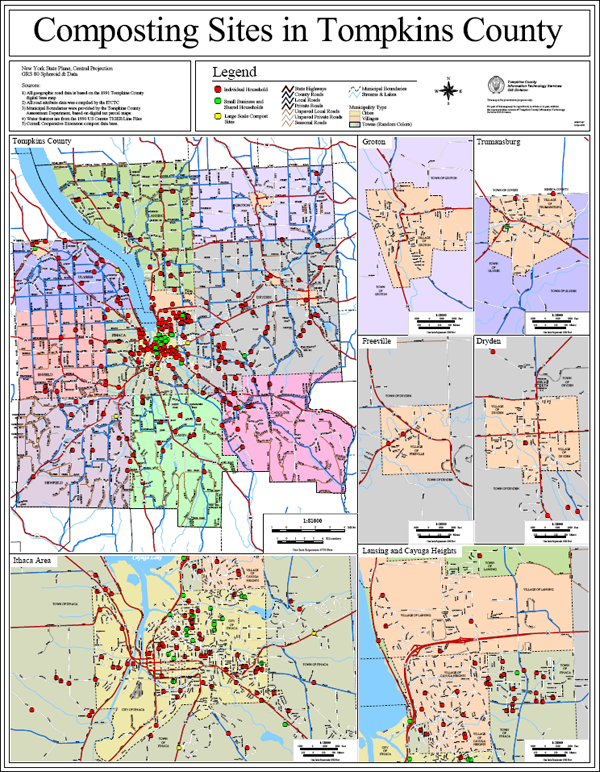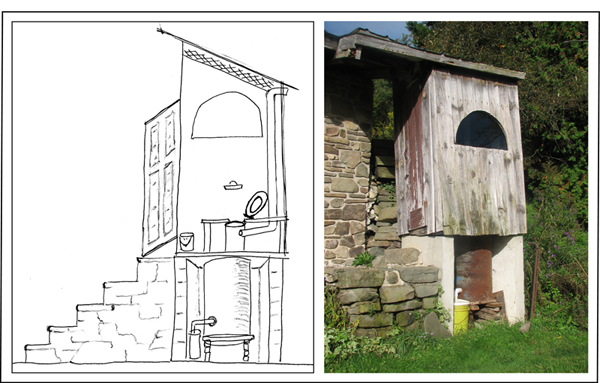food: February 2010 Archives
by Karl North
In Part One of this series, I proposed principles of agroecosystem design for growers to follow if agriculture is to approach sustainability in a future of declining access to the cheap energy and other inputs on which our industrialized food system relies. I said that providing for the local food needs of urban populations requires a design that integrates three overlapping categories of production systems: urban agriculture systems (many small islands of gardening in the city center), peri-urban agriculture (larger production areas on the immediate periphery), and rural agriculture (feeder farms associated with village-size population clusters in the hinterland of the city but close enough to be satellite hamlets). In Part Two I addressed four key issues — fertility, energy, water, and pest control — and the kinds of agroecosystems that might incorporate sustainable solutions.
In this month’s article I will picture the future county food system as a whole: its historical context and implications, and interdependencies among the parts that will make them most effective as an integrated system.
In future parts of this County Food Production series I will offer visions of each type of production system that incorporate as many of the sustainable design solutions from Part Two as seem applicable to each environment. Finally, I will explore aspects of policy and social organization that could facilitate the necessary transformation to a relocalized food system.
As the most ambitious part of this visioning project, the scenarios in this article and future ones carry the most risk of vulnerability and even failure due to historical contingencies that are impossible to predict and even hard to envisage at this juncture. Therefore, instead of a full-scale scenario for the county that could be misinterpreted as a plan, I will describe ideal types of urban, peri-urban, and rural systems to illustrate what might be beneficial or even necessary to feed the population of the county.
Learning from history: pre-fossil fuel food miles
How relocalized does a food economy need to be in the energy descent era? Throughout history, food security everywhere has been heavily dependent on a reliable supply of staple foods, especially starch staples like root crops, pulses (beans, peas, etc.) and grains. Our region once was self-sufficient in staples but gradually imported most of them. To regain food security, we must establish a measure of food sovereignty as local policy, especially in staple foods.
A look at NYS history is a reminder that easily conserved and transportable food commodities traveled far before the railroads existed, and to a degree even before the canal system was built.
Pre-canal overland commerce in high-value imports and industrial goods, paid for in farm products, was common across New York State. The account in Figure 1 shows the sorts of goods that flowed in both directions.[1]

Figure 1. Goods that historically made up the bulk of
commercial trade in 19th century rural New York
By 1830 the New York canal system linked most agricultural depots of the state to waterways--the Great Lakes and lesser lakes like Lake Champlain and the Finger Lakes to the main state rivers--and thence to the population centers and to foreign trade. Figure 2 is an account of the primary commodities in the lake traffic through Buffalo in 1847 and provides a rough measure of the tonnage and kinds of foods that moved long distances in that era.[2]

Figure 2. Great Lakes traffic arriving at Buffalo, 1847
In the late 19th century the railroads took over most transport of farm products out of rural areas; even certain bulkier items that travel well like potatoes, onions, cabbage, and livestock were included in state-wide commerce and beyond.
Apart from food security, the stimulus to the local economy and the provision of fresh, superior quality food are good reasons to produce as much food locally as possible. But consideration of the above historical perspective suggests that the question of how much we need to depend on locally produced food turns on the ability of the state to promote the revival of the railroads or, failing that, at least the canal system. The existence of long-distance trade before the era of energy ascent in products like grain that travel well suggests that during energy descent widespread trade in some agricultural products will persist despite rising transport costs.
However, many energy descent analysts[3] believe that the US economy has been so undermined by internal and external debt and dependence on fossil fuels that state and federal institutions will eventually be unable to maintain the present social order, much less take on the reconstruction of pre-oil transportation networks. This scenario suggests the need for a high level of local food production. Analysis of probable futures at this macro-level clearly suffers from the uncertainty surrounding so many of the key variables. Perhaps the best insight one can draw from the records of earlier food systems is a ranking of agricultural products for localization, according to their sensitivity to a shrunken distance economy.
Even assuming the construction or restoration of energy-efficient transport networks, other concerns ultimately will force increasing dependence on locally grown food. A sustainable food system must recycle nutrients. The historical expansion of US food miles relied first on the depletion of fertile virgin soils, then on cheap fertilizer and other manufactured inputs. Without the crutch of increasingly expensive inputs, declining agricultural yields in farms distant from consumers will force large foodsheds to shrink over time. Even proposals for the reorganization of the national and global food system into bioregional systems or foodsheds larger than counties have ignored the nutrient cycling imperative, which becomes increasingly difficult as food is grown farther from where it is eaten. This raises the question of how to feed large cities in a purported Northeast foodshed and still sustain the health of the soil that grows the food.
As early as 1862, scientists were writing of a metabolic rift that had developed between city and countryside.[4] The rift was both biological and social; the nutrient cycle had broken as the nutrients that fed urbanites no longer returned to the rural lands where the food was grown, and urbanites had lost appreciation of the fact that urban prosperity ultimately depends on the health of the land and its natural systems.
The social/cultural rift may be the biggest obstacle to change. The very existence of cities depends on the accumulation of a surplus of wealth from agriculture and other raw material extraction from the land. The temporary ability of humanity to substitute fossil fuel dependent technologies for human labor and the soil fertility and other services originally supplied by natural systems created the illusion that human labor and ecological services are of little importance in agriculture, and therefore have little bearing on the question of the survival of cities. Technology, apparently an urban product, became paramount in the hierarchy of urban cultural values. In that hierarchy, technology could even replace the social capital of healthy families and communities that traditionally gave agrarian society much of its strength and resilience.
The county needs to be ready for these challenges. The limiting factor that inhibits food system change is not biophysical knowledge of how to do it, but social knowledge of the power structures that have closed down local food economies and prevented their revival. Successful strategies for change can emerge only from a deeper understanding of how things work in the system of power relations, both in the county and beyond.
A county policy framework that effectively favors local production and reverses the power shift in modern society toward centers that today exploit peripheries will ultimately improve local quality of life. In the early 19th century, before the rise of competition from the Midwest, agrarian NY communities sold to nearby cities and enjoyed a relative prosperity that reflects the true dependence of urban affluence on the wealth of the land. Recently it was estimated that in Maine, $10 a week spent on locally produced food would put $104 million into the state’s economy.[5] This suggests that a public program to relocalize the county food economy eventually could sell politically as a core element in regenerating the local economy overall.
Interdependencies in the county food system
The three types of county agriculture to be explored in this series are best suited to different, complementary roles in county food production. Taking its cue from the pattern in earlier times, urban agriculture will give priority to production of vegetables and fruits for fresh consumption that can be grown intensively, in raised beds for example. Peri-urban agriculture will supplement urban gardens with produce that requires more space, and will support some livestock. Rural agriculture will be responsible for most of the large animal production and large-scale field cropping. A high priority of farming in satellite villages will be to grow the bulk of the staples, like potatoes, oats, roots, brassicas, legumes, squash, alliums, and apples, which have proven to be dependable in cool, temperate climates. The county will need to rely mainly on outlying farms for non-food essentials as well, such as oilseeds, flax, hemp, wool, leather, and wood.
Because the agriculture of the future will need closed nutrient cycles, fertility for all county food production cannot be considered apart from county organic waste streams.[6] To maintain fertility, organic waste must return in some form to food production sites. As the dense urban population produces the bulk of the waste, public institutions will need to take responsibility for separate collection of the purely organic component of the urban garbage and sewage waste streams, recycling part of it back to rural farms.[7]
Fertility in urban and peripheral agricultural soils can be sustained with compost from the city organic garbage stream alone. A study of one urban community revealed that urban agriculture alone could absorb 20% of the organic waste production of the city.[8] This will require a municipal policy and program of careful triage, collection, and composting at optimum C/N ratio by mixing high-nitrogen food garbage with high-carbon sources like leaves and shredded paper trash. The city could assign responsibility to urban institutional sources, such as schools and restaurants for moving their large organic waste streams to composting facilities at specific peri-urban food production sites. A map of existing Tompkins County composting sites demonstrates the composting potential (Figure 3).[9]

Figure 3. Composting sites in Tompkins County (click image for PDF version)
As for sewage, eventually Ithaca will have to desewer, converting to urban night soil collection, biogas extraction, and the recycling of residual organic matter to county farms that will be necessary to maintain the mineral content of rural agricultural soils. In the short run, guerilla humanure composting from backyard compost toilets can build toward full conversion (Figure 4). These household facilities are satisfactorily self-policed, because the product will be used in closed-cycle residential food production.

Figure 4. A functioning home-built composting toilet based on a
55 gallon drum that has been in operation in Cortland County since
1983. The drum is periodically rotated out through a composting
cycle
Conclusion
In this article, I have discussed the possibility that some of the current massive importation of the county’s food consumption could go on for decades. I pointed out serious risks to food security if this were allowed to continue, and argued that the distance economy in food causes metabolic rifts that make it ultimately unsustainable. I described in outline how a local food production system could mend the biological rift. Detailed visions of urban, peri-urban, and rural food production systems in the next articles will explain design solutions to the basic problems of fertility, energy, water supply, and pest control in specific cases of each type of production. And the reorganization of county agriculture itself will begin to address the most challenging rift, the social and cultural rift between urban and rural life.
Notes
[1] Hedrick, Ulysses Prentis. A History of Agriculture in the State of New York. Albany: New York State Agricultural Society, 1933.
[2] Ibid.
[3] Martenson, Chris. http://www.chrismartenson.com/crashcourse
Heinberg, Richard. Peak Everything: Waking Up to a Century
of Declines. Gabriola, BC : New Society Publishers, 2007.
Kunstler, James Howard. The Long Emergency. New York :
Atlantic Monthly Press, 2005.
[4] The earliest to apply the term metabolic rift to the “robbery” of country soils through the exportation of food to cities appears to have been the German chemist Justus von Liebig in the introduction to the seventh edition of his Organic Chemistry in its Application to Agriculture and Physiology. The term was later used by Karl Marx and others. See Foster, J.B., “Marx’s ecology in historical perspective,” http://pubs.socialistreviewindex.org.uk/isj96/foster.htm and Clausen, Rebecca, “Healing the Rift: Metabolic Restoration in Cuban Agriculture,” Monthly Review, May 2007.
[5] Community Food Security Coalition. “Urban Agriculture and Community Food Service in the United States: Farming from the City Center to the Urban Fringe.” FoodSecurity.org. October 2003. http://www.foodsecurity.org/PrimerCFSCUAC.pdf
[6] For information about local waste processing facilities, see the TCLocal article “Wasting in the Energy Descent: An Outline for the Future” by Tom Shelley, http://tclocal.org/2009/01/wasting_in_the_energy_descent.html
[7] Tom Shelley has recently begun to prototype this process with “The Sustainable Chicken Project,” which returns nutrients to the land by collecting kitchen scraps in the City of Ithaca on a subscription basis and feeding them to chickens at Steep Hollow Farm three miles outside the city in the Town of Ithaca. See http://www.sundancechannel.com/sunfiltered/2010/01/sustainable-chicken-project/ and the farm’s blog at http://steephollowfarm.wordpress.com/
[8]Mougeot, Luc J.A. Growing Better Cities: Urban Agriculture for Sustainable Development. Ottawa: International Development Centre, 2006. http://www.idrc.ca/openebooks/226-0/
[9] http://www.co.tompkins.ny.us/gis/maps/pdfs/CompostMap2000-E.pdf
